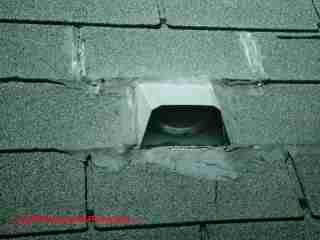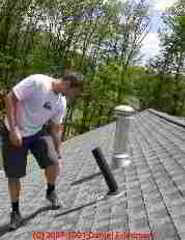 Backdrafting, Wet Weather & Causes of Sewage or Septic Odors
Backdrafting, Wet Weather & Causes of Sewage or Septic Odors
- POST a QUESTION or COMMENT about backdrafting and wet weather causes of sewage or septic odors and smells at or in buildings
This article discusses the role of back drafting in buildings, exhaust fans, or other building air movement in causing sewer gas or septic odors (and other building smells and odors).
This article is part of our series SEWER GAS ODORS that helps track down and cure the source of sewer gas or septic smells in buildings.
InspectAPedia tolerates no conflicts of interest. We have no relationship with advertisers, products, or services discussed at this website.
How Back-Drafting Can Cause Sewer Gas Odors in buildings
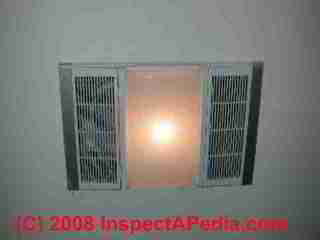 What is "Backdrafting" in buildings?
What is "Backdrafting" in buildings?
"Backdrafting" refers to indoor conditions that create sufficient negative air pressure inside a building such that gases may be drawn into the building from a plumbing drain system or such that heating appliances may lack adequate combustion air and may produce dangerous carbon monoxide.
Watch out: backdrafting in a building can be dangerous, causing intake of explosive methane gases from a sewer system, or potentially fatal carbon monoxide gas hazards from heating appliances.
In this article (below) we discuss the causes, effects, and cures for backdrafting in buildings that affects the building plumbing drain vent system. Unsafe heating appliance conditions caused by backdrafting are discussed
at BACKDRAFTING HEATING EQUIPMENT
where we discuss dangerous backdrafting conditions that can make heating appliances unsafe and can produce potentially fatal carbon monoxide gas hazards in buildings.
What Causes Building Backdrafting Hazards?
Any one or more of the factors listed below can create negative air pressure inside a building such that backdrafting occurs or may occur at building drains or plumbing vents:
- Bathroom or kitchen exhaust fans create negative air pressure at least in those rooms in order to exhaust bathroom or cooking odors. Also
see BATHROOM VENTILATION CODES SPECS. - Doors open between a basement and upper building areas may provide a path for basement or crawl space air (and odors) to pass to upper building levels.
- Exhaust-only ventilation systems in buildings can create backdrafting conditions, especially in tight buildings.
See VENTILATION, EXHAUST ONLY, and for a cure
see VENTILATION, BALANCED. - Fireplaces, when in use, particularly open fireplaces that do not include an air-tight glass fire screen or door, create significant air movement out of the building and up the chimney, potentially causing backdrafting in other building areas.
- Rain, wet weather, and local flooding can cause sewer gases to back up through building drains, moving (properly) up through building vent piping to above the building roof, or moving (improperly) into the building through dry traps and drains.
- Sewer gas reentry into buildings: can occur when a plumbing vent is improperly located too close to a window, door, soffit vent, or even a bath or kitchen vent duct as we illustrate in the field report given below. The reentry of sewer gases into a building is more likely when:
- Wind from a particular direction pushes sewer gases from a source towards building openings, windows, doors, vents
- Other site conditions (rain, sewer or storm drain flooding) create higher than normal levels of sewer gases venting through a building's plumbing vent system
- Tight building construction with minimal air leaks, a desirable practice for saving on building heating or cooling costs, reduces the ready supply of outdoor makeup air when any other building condition is causing air movement out of the structure. The lack of easy entry of makeup air can add to backdrafting dangers in a building.
- Warm air rising in a multi-story building by natural convection during cold weather creates negative air pressure on lower floors, potentially drawing sewer gases out of dry traps, drains, or faulty plumbing vent piping
- Whole house ventilation exhaust fans create very powerful negative air pressure in buildings sufficient to cause backdrafting affecting both plumbing system drain/waste/vent piping and heating appliances.
- Windows open on upper building floors and closed on lower building floors increase air movement upwards in buildings.
Field Report: Example of Rooftop Plumbing Vent Backdrafting Causing Sewer Gases to Enter a Building - and The Cure
Sewer/Storm Drain Flooding: indoor sewer gas odors have been tracked to a combination of wet weather, flooding sewer and storm drains, and backdrafting in the building due to improper bathroom exhaust fan vent installation.
Our photo (left) shows a poorly-installed rooftop bath vent fan outlet, patched to try to stop leaks, and likely to be blocked by snowfall on the roof surface. But you can see the "flapper" that closes this vent opening when the fan is not running.
Reader Jose Iturraspe provided the following sewer gas odor diagnosis and cure field report:
A customer complained of sewer smell in the home that occurred only when it rained, and only in his master bath.
Inside, at the exhaust fan housing in the ceiling, we found that there was no flapper. [The flapper is designed to stop indoor air movement up out through the exhaust fan system when the fan is not turned on.]
Outside, on the roof, the exhaust fan gooseneck had no flapper either. [The rooftop flapper is designed to keep birds, insects, and in some climates wind-blown rain or snow out of the exhaust fan system when the fan is not running.]
The plumbing vent was located about 2’6” from the exhaust fan gooseneck.
We replaced both flappers in the bathroom exhaust fan system, and the sewer gas odor issue has gone away.
My best guess is that during a rain, the storm drain/sewer had its sewer gas displaced with the rain water runoff, pushing the gas out the plumbing vents.
At the same time we think that the winds combined with the missing flappers on the bath exhaust fan created a situation where the gas was being sucked in thru the exhaust vent goosenecks.
See CORROSION & MOISTURE SOURCES in PANELS for examples of how backdrafting or negative building air pressure can cause unexpected air and moisture movement, condensation, and moisture-related problems such as rust, corrosion, or odors, or mold.
Use of this information at other websites, in books or pamphlets for sale is reserved to the author. Technical reviewers are welcome and are listed atReferences or Citations .
Reader Comments, Questions & Answers About The Article Above
Below you will find questions and answers previously posted on this page at its page bottom reader comment box.
Reader Q&A - also see RECOMMENDED ARTICLES & FAQs
On 2021-02-06 by (mod) - we confused reader comment about "fresheners" (a type of air vent) with odor fresheners or air "fresheners"?
Anon
I'm sorry you felt accused; we made quite clear that when you referred first to using an "air freshener" as a cure for sewer gas odors, our search to find more information turned up nothing on the product you ultimately identified, but only provided links to air fresheners like the product now illustrated below, leaving us to worry about using an odor freshener device by that name.
Subsequently you made clear that you were discussing a ventilation device - apparently a PVC pipe with fittings intended to permit outdoor fresh air to enter a building, making clear what we were discussing.
But I appreciate your concern, have removed your name, and have edited to make this topic clear;
Question: are you connected with the maker or sale of the device we discussed? If so we'd sure like some technical specifications such as dimensions and pipe diameter and any information on actual air flow that the device permits; Is there a control valve that opens the device only when indoor air pressure falls with respect to outside or is the device always open to the exterior? Are there drafts?
Thanks so much.
Don't feel humiliated; most-likely you have not made as many mistakes in life as I have, nor had as much egg on face;
InspectAPedia.com provides building and environmental diagnostic and repair information.
In order to absolutely assure our readers that we write and report without bias we do not sell any products nor services, nor do we have any business or financial relationships that could create such conflicts of interest.
InspectAPedia is an independent publisher of building, environmental, and forensic inspection, diagnosis, and repair information for the public - we have no business nor financial connection with any manufacturer or service provider discussed at our website. We very much welcome critique, questions, or content suggestions for our web articles.
On 2021-02-05 by [Anonymous]
Please delete my comments. Your response accuses me of using some sort of air freshener and ignoring the hazards of sewer gas. I used my real name and it is a bit humiliating.
On 2021-02-05 by (mod) - in well-sealed "tight houses" even a small exhaust fan can create negative pressures
Indeed, [Anon], particularly in well-sealed "tight houses" even a small exhaust fan can create negative pressures. But I suspect that if a trap is being siphoned it's also because the plumbing vent system is not installed properly or is blocked; if there is adequate venting in the vent piping system then traps won't siphon or lose their water seal.
The problem of a floor drain trap drying-out and thus venting sewer gases is, of course, a different phenomenon.
I agree with you that opening a window to solve a drain-waste-vent problem like those I just listed is not the best approach and as I warned earlier, could leave serious building safety hazards in place.
Thank you for the discussion.
On 2021-02-05 by [Anon]
I think a lot of these sewer gas smells are caused by a lack of make up air when an exhaust fan is operating. I know it doesn't make sense because exhaust fans aren't supposed to drop pressure enough to draw gases through drain traps, but it happens in my house.
I figured it out because others had posted the same issue and solved it by opening a window.
On 2021-02-04 by (mod) - make safer use of the any outdoor air vent by first diagnosing the odor source, fixing the cause, and checking for life-safety concerns
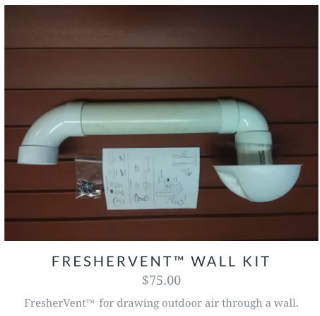 Thanks Tim, I had tried searching for the Freshervent™ when you first mentioned it and found not a shred of information. With your link I could take a look at the inventor's web page - and include an example of his product below.
Thanks Tim, I had tried searching for the Freshervent™ when you first mentioned it and found not a shred of information. With your link I could take a look at the inventor's web page - and include an example of his product below.
The inventor's claim is that by admitting fresh air into the home using the freshervent we stop a backdrafting problem that might cause septic odors.
The concept is reasonable but incomplete, and, disappointingly, there is no technical data about the product that match air flow to backdraft causes, nor any warnings about what I consider the first priority: life safety issues.
Illustration: the Freshervent™ wall vent kit discussed here. The company's website fresehrvent.com sells this kit for $75. USD.
[Click to enlarge any image]
Watch out: When a building suffers from negative air pressure enough to siphon water from a plumbing trap there are companion risks that need to be stated such as improper combustion of gas fueled appliances, risking fatal carbon monoxide poisoning, and on occasion, a few times a year, a septic gas accumulation leading to a methane gas explosion that can take down a building.
The concept of adding outside air is proper, but the freshervent's capacity to provide air is not stated nor are there instructions about the relationship between odors and hazards nor between odors and their cause.
It is always far safe to find and diagnose the cause of odors and unsafe conditions than it is to apply a partial fix to the complaint.
So an outside ventilation air source can be a good idea, surely having some applications, but in my opinion, incomplete and leaving potentially fatal hazards un-addressed.
Here is a simple example:
A sewer gas odor in a laundry room might be due to the presence of a floor drain whose trap seal of water has evaporated.
Sewer gases may flow back up from the sewer or septic and out of the floor drain, and when any exhaust fan (like a clothes dryer) is operating, that flow may be increased.
The proper fix is to simply fill the trap again with water or, for a longer-lasting trap seal, mineral oil or baby oil.
What can be missing from that odor story are more-dangerous backdrafting issues in the same building, such as inadequate combustion air for a heating appliance, water heater, furnace, boiler.
In a tight building and when such equipment is installed in a small space that can be enclosed (like a utility room or boiler room) the risk is both unsafe and unreliable heater operation and worse, fatal CO poisoning that I mentioned before.
Both oil and gas burners require a volume of combustion air that depends on the input BTUh rate of the burner.
For example an oil burner needs about 1 square-inch of un-blocked (un-screened) input of outside combustion air per 1000 BTUh of burner capacity.
A typical 100,000 BTUh oil burner in a small space then needs 100 square inches of air supply before the effects of any screening or louvers on that vent opening. After we add the effects of screening or louvers on a vent opening (to keep out critters and bugs) we might need 150 or even 200 sq.in.
A 3-inch diameter plastic vent pipe (the Freshervent does not give the diameter of that pipe) provides about 7 square inches of vent opening. That is nowhere near, not even in the ballpark, of what a heating appliance might need.
So in my view, while there are good uses for providing fresh outdoor air into some building areas, particularly tight buildings, the potential concerns extend far beyond an occasional whiff of sewer gas and include, in the worst case, CO poisoning and building explosions and fatalities.
So it behooves all of us to be careful when tracking down and fixing sewer gas and backdrafting odors, to diagnose the cause of the odor, address and fix the cause (inadequate plumbing venting, dry floor traps, or more-serious inadequate combustion air conditions) and to address possible life-safety concerns first.
Details are at
BACKDRAFTING HEATING EQUIPMENT - Building ventilation mistakes can cause backdrafting and fatal carbon monoxide gas hazards in buildings.
CLOTHES DRYER INSTALLATION & VENTING MANUALS - clothes dryer venting installation guides in dryer instdallation manuals
COMBUSTION AIR for TIGHT BUILDINGS
FRESH AIR VENTILATION RATES & STANDARDS Typical fresh air ventilation requirements for buildings are in the 5-10 cfm per person range, varying by type of occupancy.
And for a more-sophisticated approach to ventilation that permits introducing freshoutdoor air without losing heat to the building exterior, see
Incidentally, excluding what may be a patented indoor vent hood, standard plumbing parts to make up a 3-inch thorugh wall vent would cost roughly: $26.00 U.S. - about 1/3 of the patented product discussed above.
Note, as we explain above, we are NOT recommending the ventilation parts and approach listed below.
Two 90 degree elbows @ maximum retail $11.00
One 10 ft. length of 3" PVC Pppe (shortest easily bought) @ retail $10.00
One Oatey 3-inch drain screen (we don't see a screen on the shown at page top) @ $5.00
On 2021-02-04 by Anonymous - A Freshervent is not an "air freshener", it is a make up air vent.
A Freshervent is not an "air freshener", it is a make up air vent. www.freshervent.com
On 2021-02-02 by (mod) - using an "air freshener" to treat backdrafting sewer gas odors? If so that would be unsafe
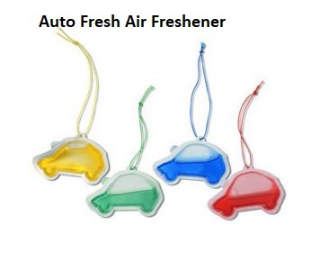 Really? Well, no. Subsequent discussion with this reader given just above explained that he was discussing a venting system called "Freshervent" and not an odor-covering "air freshener".
Really? Well, no. Subsequent discussion with this reader given just above explained that he was discussing a venting system called "Freshervent" and not an odor-covering "air freshener".
The following warning pertains to readers who consider using odor killers or air fresheners or fragrance diffusers in an effort to cover sewer or gas odors, and emphasizes that for any indoor sewer gas odor it is important to find and fix the cause rather than to stop at treating the symptom.
Watch out: IF the product you describe is an air "freshener" such products do absolutely nothing to remove harmful gases from the air; rather they release a pleasant-smelling perfume odor that overlays the noxious odor. The result may smell better but it leaves the original gas present and it does nothing to find and fix a potentially dangerous sewer gas source,
If there are backdrafting odors in the building then there is certainly a cause that we can and should track down and fix, because otherwise we may be leaving a safety hazard un-addressed.
Sewer gases contain pathogens (you can get sick) and also methane (an explosive gas).
See details at METHANE & SEWER GAS HAZARDS
and at TRACK SEPTIC / SEWER ODOR to SOURCE
Furthermore, as your comment is on an article about "Backdrafting" we add that backdrafting itself can, in a building, result in dangerous, even fatal carbon monoxide poisoning.
So the right solution is to find and fix the problem; don't stop at just making the building smell better, whether by using an odor covering device or by admitting more outdoor air before we know the cause of the trouble..
Also see CARBON MONOXIDE - CO
On 2021-02-01 by Anonymous - I had a sewer gas smell when I ran my dryer.
I had a sewer gas smell when I ran my dryer. I couldn't find a problem with my venting, so I finally installed a Freshervent to allow make up air into the laundry room. That was my fix.
On 2020-12-21 by (mod) - add an air admittance valve AAV at sink suffering drain-vent odor problems?
The idea of an air admittance valve is an interesting one and not something I've considered. It's certainly safe and reasonable to give it a try.
When we don't know the cause of a drain/waste/vent problem, or odor, I prefer to find the cause in principle because I want to be sure the system is sanitary and safe.
Homing in on where odor is strongest, paying attention to traps to see if they're being sucked dry, can be diagnostic. Sometimes the ODOR LOG that we provide can help by relating the presence of an odor to operation of building equipment or fixtures.
On 2020-12-21 by Sophia Robinson
Thank you for all your responses, it has been so hard to find help. Would it be helpful to put AAVs on our sink and caped of drain where the odor is the strongest? Do you have any ideas? We took the wall off where the odor is and didn't find any pipes that were disconnected.
We are willing to try almost anything. Thank you for answering all my questions.
On 2020-12-19 - by (mod) -
Indeed there may be too many fixtures on the vent line, or the piping distances too great for proper venting.
A result can be trap siphonage and odors at nearby fixtures.
Telling you that you shoulld keep water in the P-traps is a weak effort to avoid an odor problem; the root problem may be that the traps are being siphoned dry by inadequate venting.
Consider that it is not normal nor reasonable for building occupants to have to repeatedly pour water (or mineral oil) into building traps that are at fixtures in regular use.
On 2020-12-19 by Anonymous
Thank you for writing back again, maybe if I share a little more you can continue help me further.
We live in a beat-up rental. We are fixing up the place for rent credit. Also, our place was originally a one big house. We noticed that after our neighbor moved out, we rarely smell the sewage. We sometimes smell it when we drain the tub, but it quickly goes away.
After climbing under the house we saw that the neighbor's drain connects to ours just before it connects to our bathroom sink and is vented up and inside the wall. We also do not see any vents on the outside of their place.
They could have some that go though the roof, but there is another roof of top. We are wondering if there are too many fixtures on the little 2" that goes though our wall.
We really are stumped and all the plumber told we have to keep water in the p-traps.
Thank you and suggestions are appreciated!
On 2020-12-14 - by (mod) -
Sophia
Continuing from my prior response to, if you capped off an unused drain and there are still odors in that area I would be looking for either another leak in that drain waste or vent piping system or prior still that leaked into a wall cavity and was not properly or thoroughly cleaned up. The other suggestions I offered including an odor log can help any even in the case that you described as you might find that other building conditions are irrelevant such as air movement
On 2020-12-14 by Sophia Robinson
I am not sure if you are replying to me. If you are thank you. I realized that I forgot to put where the odor is. It is strongest where the old capped off drain is, it smells on the other side of the wall where the working sink is as well, but not as strong. I have read all the articles.
There is no rhyme or reason to the smell, it is not when we flush the toilet or after we shower, or run the dishwasher, this is why it is so hard to diagnose. One idea we had to was to connect an elbow joint and extend the vent pipe up to the roof. The vent currently goes up from the bathroom to the second floor, makes a 90 and goes straight to the outside in between the first and second floo
r. The vent comes straight out between the downstairs and upstairs....weird house, weird plumbing. Thank you again.
On 2020-12-13 - by (mod) -
I'd like to start by forming an opinon of just where the sewer gas is most-strong. That can point to a dry trap, loose toilet, etc.
Take a look at the diagnostics starting at TRACK SEPTIC / SEWER ODOR to SOURCE
and also see if ODOR DIAGNOSIS EVENT LOG & CHECKLIST
where we give suggestions for keeping track of what's going on in a building that helps track down odors and where we suggest keeping
this
ODOR EVENT LOG & CHECKLIST FORM printer-friendly PDF file to record odor observations such as time of day, weather, temperature, sunlight, & possible sources as an aid in finding the actual source of odors & smells in or around buildings
On 2020-12-13 by Sophia Robinson
We have an old crazy house. Let me try to explain this and hope it makes sense. In the winter our house smells like sewer. It's nasty. The smell comes and goes though out the day. I have read all the post that I could find that are both relevant and irrelevant. So, here it goes.
Above the house we have a drain line that has two sinks, one on either side of the wall. One sink is not in use and the sewer drain has been capped off. The other sink that is being used has is vented up one story and makes a 90 at the second floor then goes on the back of the house. This is all on one line, a vent out the back of the house, a working sink and an old sink that has been capped off. The smell is awful.
We have tried to run the faucet (for the unused sink), put a p-trap and keep water in it. Climb under the house and look for leaks. We have taken down part of the wall to look for pipes that have been disconnected. We don't know what else to do. Plumber and contractors are confused, and our house still smells. Please let us know if you have any ideas. I hate being the stinky family.
On 2020-11-15 - by (mod) -
Thank you for the helpful comment, Thomas.
A trick for traps serving fixtures that are seldom used also works in floor drains: we pour in some mineral oil. It's harmless, not toxic, so if water comes to the drain or trap and sends the mineral oil into the septic or sewer system no harm is done. But the oil doesn't evaporate so quickly as will the water.
On 2020-11-11 by Thomas
As mentioned in the article above, dry traps are a problem. Floor drain traps are problematic because most people don't know they need attention. A couple cups of water every month should take care of it. More during dry times of the year.
Of course, the wet bar that isn't used or the shower stall in the guest bathroom that is seldom used also need attention. Keep your traps filled and run some water through them to get rid of the stale water sitting in the trap.
On 2020-08-15 by Anonymous
It has been hot and humid where I live and now my house stinks of sewage. Basins and bath are draining free. What can I do?
On 2020-08-15 by Michelle
Whenever our house is closed up and we’re running the fireplace or our portable air conditioner (has hose attachment to push air out the window), we have terrible sewer gas odors in the house. It’s worse in the laundry room and the room with a shared wall to the laundry room. The smell is making us sick.
...
Continue reading at TRACK SEPTIC / SEWER ODOR to SOURCE or select a topic from the closely-related articles below, or see the complete ARTICLE INDEX.
Or see BACKDRAFTING SEWAGE ODOR FAQs - questions & answers posted originally in this article
Or see these
Recommended Articles
- BACKDRAFTING HEATING EQUIPMENT - home
- COMBUSTION AIR for TIGHT BUILDINGS
- INDOOR AIR QUALITY & HOUSE TIGHTNESS - good design for indoor air ventilation systems
- METHANE & SEWER GAS HAZARDS
- METHANE GAS SOURCES
- ODOR DIAGNOSIS EVENT LOG & CHECKLIST
- ODOR EVENT LOG & CHECKLIST FORM
- ODORS GASES SMELLS, DIAGNOSIS & CURE - home
- PLUMBING SYSTEM ODORS - home - guidance in tracking down plumbing smells
- SEPTIC SYSTEM ODORS - home
- SEWER GAS ODORS
- TRACK SEPTIC / SEWER ODOR to SOURCE
Suggested citation for this web page
BACKDRAFTING & SEWER/SEPTIC ODORS at InspectApedia.com - online encyclopedia of building & environmental inspection, testing, diagnosis, repair, & problem prevention advice.
Or see this
INDEX to RELATED ARTICLES: ARTICLE INDEX to BUILDING ODOR DIAGNOSIS & CURE
Or use the SEARCH BOX found below to Ask a Question or Search InspectApedia
Ask a Question or Search InspectApedia
Try the search box just below, or if you prefer, post a question or comment in the Comments box below and we will respond promptly.
Search the InspectApedia website
Note: appearance of your Comment below may be delayed: if your comment contains an image, photograph, web link, or text that looks to the software as if it might be a web link, your posting will appear after it has been approved by a moderator. Apologies for the delay.
Only one image can be added per comment but you can post as many comments, and therefore images, as you like.
You will not receive a notification when a response to your question has been posted.
Please bookmark this page to make it easy for you to check back for our response.
Our Comment Box is provided by Countable Web Productions countable.ca
Citations & References
In addition to any citations in the article above, a full list is available on request.
-
a Florida home inspector and home inspection educator. Contact Mark Cramer at: 727-595-4211 mark@BestTampaInspector.com 11/06
- Roger Hankey is principal of Hankey and Brown Inspections, Winter Park, CO. Mr. Hankey is a past chairman of the ASHI Standards Committee and served in other ASHI chapter and national leadership roles. Mr. Hankey is a National Radon Proficiency Program certified measurement professional and a Level II infrared thermographer. Contact Roger Hankey at: 970-393-6604 - rogerhankey47@gmail.com . Website: www.HankeyandBrown.com Mr. Hankey is a frequent contributor to InspectAPedia.com.
- Arlene Puentes [Website: www.octoberhome.com ] , an ASHI member and a licensed home inspector in Kingston, NY, and has served on ASHI national committees as well as HVASHI Chapter President. Ms. Puentes can be contacted at ap@octoberhome.com
- In addition to citations & references found in this article, see the research citations given at the end of the related articles found at our suggested
CONTINUE READING or RECOMMENDED ARTICLES.
- Carson, Dunlop & Associates Ltd., 120 Carlton Street Suite 407, Toronto ON M5A 4K2. Tel: (416) 964-9415 1-800-268-7070 Email: info@carsondunlop.com. Alan Carson is a past president of ASHI, the American Society of Home Inspectors.
Thanks to Alan Carson and Bob Dunlop, for permission for InspectAPedia to use text excerpts from The HOME REFERENCE BOOK - the Encyclopedia of Homes and to use illustrations from The ILLUSTRATED HOME .
Carson Dunlop Associates provides extensive home inspection education and report writing material. In gratitude we provide links to tsome Carson Dunlop Associates products and services.


